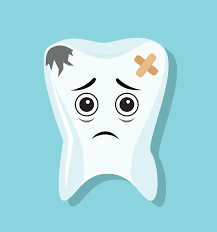 Starchy and sugary food sticks to your teeth and remains there, creating a breeding ground for bacteria and cavities. Contributing to the plaque growth, food particles become acid. The acidic substance stays onto the teeth, damages the hardest layer (enamel), and makes hollow spaces, called cavities. It further causes tooth decay as these hollow cavities grow and damage your teeth’s structure while ruining your bright smile. As they say, you are what you eat. Eat food that harms your teeth and you will end up with damaged teeth.
Starchy and sugary food sticks to your teeth and remains there, creating a breeding ground for bacteria and cavities. Contributing to the plaque growth, food particles become acid. The acidic substance stays onto the teeth, damages the hardest layer (enamel), and makes hollow spaces, called cavities. It further causes tooth decay as these hollow cavities grow and damage your teeth’s structure while ruining your bright smile. As they say, you are what you eat. Eat food that harms your teeth and you will end up with damaged teeth.
In order to prevent cavities, it is important to identify the early signs of tooth decay before you take any action. The following guidelines will help you detect warning signs.
Is Your Tooth Decaying?
Visit your dentist if you notice the following tooth decay symptoms.
- Discoloration of Teeth – If you find some opaque and dusty spots on the enamel, i.e. the topmost translucent layer of the tooth, this may be the sign of a cavity.
- The Stickiness of The Teeth – Cavities increase the stickiness of your teeth when food particles get stuck on your teeth after every meal. Have a thorough glance at your teeth in the mirror.
- Difficulty in Chewing – Dental decay is another sign of cavities and can make it difficult for you to chew your food. This happens when the cavity reaches the tissues and pulp and damages the connecting bone.
- Tooth Sensitivity – Your teeth become sensitive to cold and hot beverages and edibles when cavity kills the protective layer of your teeth (enamel).
- A Toothache – Sharp pain while biting something hard is a sign that your teeth are decaying. To protect your teeth from becoming prone to dental disorders and fractures, pay a visit to your dentist.
- Halitosis – Stuck food particles is a significant factor due to which your mouth produces an unpleasant odor.
- Damaged Gum Tissues – Gum tissues grow if there is a cavity between your teeth. It damages tissues and causes them to bleed when you brush.
- Swollen Gums – Your gums get swollen as the cavity damages tooth tissues reaching the pulp. The condition requires immediate treatment.
How Can You Treat Cavities?
There are several treatments for dental cavities. Fillings remain the simplest and most painless treatment where a damaged portion of the tooth is replaced with a filling. The common types of fillings include:
- Silver Fillings – Amalgam is used in this filling as they are affordable and easily available. However, they make the filling noticeable, especially if used on the back of your teeth.
- Gold Filling – It is expensive and long-lasting. Not only does it stay on your teeth more than 20 years, but also it is gum-friendly.
- Plastic Fillings – It is also called composite and has the quality to blend in the natural color of your teeth. However, they are temporary and get discolored or chipped within months.
- Porcelain Fillings – These fillings are permanent as a dental specialist crafts them. Not only do they stay on your teeth but suit your teeth perfectly. However, no insurance policy covers porcelain fillings due to the exorbitant treatment.
In other severe cases, dentists choose longer treatments, like crowns or caps. If the cavity damages the root of your tooth, a root canal is an option to protect your tooth.
So, it is important that you stay vigilant and detect any early signs of cavities. Take good preventative care by visiting the dentist at least twice in six months. It will help you keep your smile bright and white.





